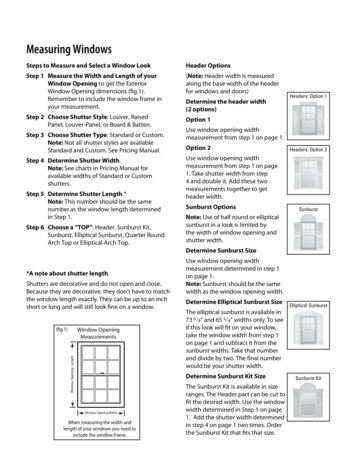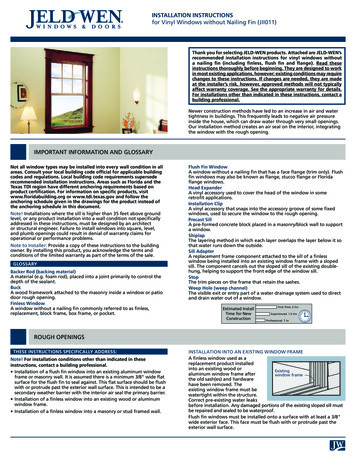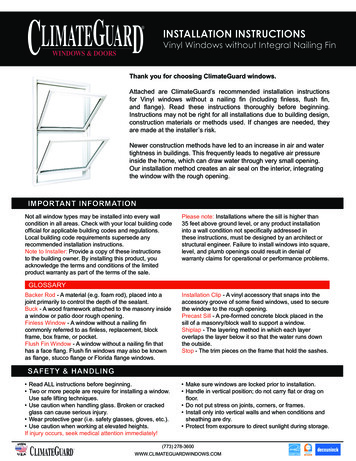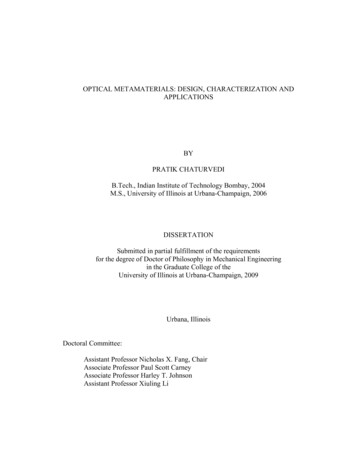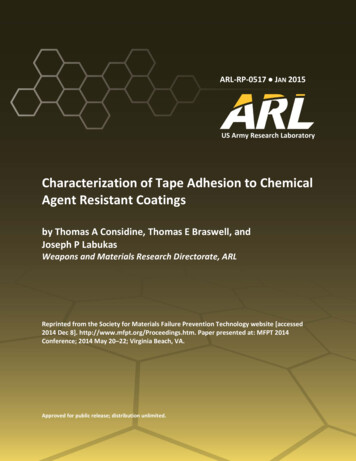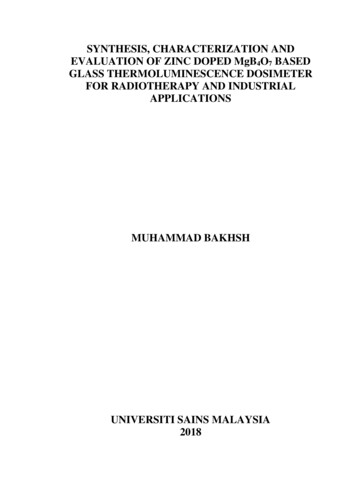
Transcription
3.2. Characterization of Vinyl Ester /Styrene Networks3.2.1. IntroductionAlthough vinyl ester resins have been used in industry for more than thirty years, not muchinformation is available in the literature on the formation-structure-property relationships inthese networks.1, 2, 3 These networks are becoming increasingly important in fiber reinforcedcomposites because their cure characteristics are compatible with rapid composite processingoperations such as pultrusion and resin transfer (or resin infusion) molding. The free radicalcure mechanism allows for good stability at low temperatures, as well as rapid reaction atelevated temperatures. Therefore, it is of great scientific and technological interest to studyand understand the structure and properties of vinyl ester networks.Crosslink density is one of the most important structural parameters which control theproperties of vinyl ester resins. This can be controlled by varying the styrene content in theresin, by controlling the final double bond conversion, and/or by changing the molecularweight of the vinyl ester oligomer. In this chapter, the crosslink densities of vinyl esternetworks were determined from elastic moduli above the glass transition temperatures and viaswelling experiments. The effect of crosslink density on network properties such as glasstransition temperature are discussed. Characteristics of vinyl ester networks such as shrinkageand toughness have been measured at systematically varied levels of styrene monomer. Theeffect of styrene, molecular weight of vinyl ester oligomers and the cure temperature onproperties of vinyl ester networks are discussed in this chapter.1M. Ganem, E. Lafontaine, and B. Mortaigne, J. Macromol. Sci., Phys., B33(2), 155, 1994.2I. Yilgor, E. Yilgor, A. K. Banthia, G. L. Wilkes, J. E. McGrath, Polym. Composites 4, 120, 1983.3I. K. Varma, B. S. Rao, M. S. Choudhary, V. Choudhary, and D. S. Varma, Die AngewandteMakromolekulare Chemie 130, 191, 1985.74
3.2.2.Crosslink Density of Cured Vinyl Ester ResinsCrosslink density, typically given as the average molecular weight between crosslinks(Mc), isan important factor governing the physical properties of cured thermoset resins. Vinyl esteroligomers have double bonds at each end that can be crosslinked. The crosslink density canbe changed by adjusting the styrene content in the resins, adjusting the molecular weight ofvinyl ester oligomers, altering the state (and also possibly the rate) of conversion, and controlof the cure conditions, among others. In this study two series of vinyl ester (with two differentnumber average molecular weights, 700 and 1000 g/mol) resins with varying styrene contents(from 20 wt % to 60 wt %) were studied.There are several methods which can be used to determine the crosslink densities of highlycrosslinked thermoset materials. Examples are swelling measurements and determination ofthe modulus at temperatures well above the glass transition temperature.4 -6 Solvent swellingdata can give absolute values for crosslink density. However, the absolute crosslink densitycan only be obtained when accurate values of the Flory-Huggins polymer-solvent interactionparameter are available. For thermosets one frequently employed method is to calculate Mc byusing the value of modulus in the rubbery plateau region.7, 84A. R. Shultz in Characterization of Macromolecular Structure, D. McIntyre ed., Publication 1573,National Academy of Science, Washington, DC, 1968, p389.5L. E. Nielsen, J. Macromol. Sci, Revs. Macromol. Chem., C3(1), 69, 1969.6Encyclopedia of Polymer Science and Technology, Vol 4, 350, N. M. Bikales, G. C. Overberger,and G. Menges, Eds., Wiley Publications, New York, 1988.7Encyclopedia of Polymer Science and Technology, N. M. Bikales, G. C. Overberger, G. Menges,Eds., Wiley Publications, New York, 1988, Vol 3, p 306.8L. W. Hill, PMSE Preprints, 387, Spring, 1997.9L. W. Hill, Paint and Coating Testing Manual, J. V. Koleske Ed., Fourteenth Ed. Gardner-SwardHandbook, ASTM, Philadelphia, PA, 1995; Ch. 46, p. 534.10L. E. Nielsen, J. Macromol. Sci-Revs. Macromol. Chem., C3, 69, 1969.75
According to the theory of rubber elasticity the equilibrium elastic modulus is given by 9-10ρ G’/RT E’/3RT(1)where ρ is the crosslink density expressed in moles of elastically effective network chains percubic centimeter of sample, G’ is the shear storage modulus of the cured network at atemperature well above Tg, R is the gas constant and T is the absolute temperature at whichthe experimental modulus is determined. The statistical theory of rubber elasticity was derivedbased on four basic assumptions (1) an individual network chain obeys gaussian statistics; (2)upon deformation, crosslink junctions transform affinely; (3) the internal energy of the systemis independent of the conformations of the individual chains, and (4) the chains are treated asphantom networks (there is no excluded volume)11. For highly crosslinked systems theequation (1) will not hold any more. However, the elastic modulus is still independent of thechemical structure of the network and depends primarily on the tightness of the networkstructure. The elastic modulus at temperature above Tg is still a good empirical method ofcharacterizing highly cross-linked materials. There have been numerous studies reported onapplication of theory of rubber elasticity for the rubbery region of highly crosslinked networkssuch as epoxy, 12-14 polyester, 15 and bismaleimide system. 16For highly crosslinked networks, chain entanglements are not present and, under smalldeformations, the relationship between crosslink density and the equilibrium elastic modulus11Introduction to Polymer Viscoelasticity, J. J. Aklonis and W. J. Macknight ed., Wiley-interscience,nd2 edition, 1983, p111.12E. Urbaczewski-Espuche, J. Galy, J. Gerard, J. Pascault, and H. Sautereau, Polym. Eng. Sci., 31,1572, 1991.13G. Levita, S. Petris, A. Marchetti, and A. Lazzeri, J. Mater. Sci., 26, 2348, 1991.14D. Katz and A. V. Tobolsky, J. Polym. Sci., 4, 417, 1963.15T. M. Donnellan and D. Roylance, Polym. Eng. Sci., 32, 415, 1992.16D. Katz and A. V. Tobolsky, J. Polym. Sci., Part A, 2, 1587, 1964.76
can be expressed by using the kinetic theory of rubber elasticity (Equation (1)). Here G’ E’/3 is used, assuming that the samples do not undergo volume change with tensile strain(χ 0.5).DMA was used to determine mechanical properties and glass transition temperatures of thevinyl ester networks. The curves of the storage and loss moduli and the loss tangents as afunction of temperature were obtained. The temperatures of the maxima in the loss tangentsare taken as the glass transition temperatures. The DMA instrument was a Perkin ElmerDMA-7e. The heating rate was 5 oC/min. and frequency was 1Hz under amplitude control.The strain amplitude was set at between 7-10 µm depending on the thickness of the samplesso that the sample deformation was controlled at about 0.5%. The samples had sizes of 2.5-3mm in thickness, 5.9-6.2 mm in width, and 18-20 mm in length.The storage modulus above Tg was used to estimate the crosslink densities of the vinyl esternetworks. The vinyl ester networks tested have well defined transition regions and rubberyplateau regions. In the rubbery plateau region, the storage modulus changes only slightly withtemperature. To a first approximation, the modulus in the rubbery plateau were considered asconstant up to the chemical degradation temperature. It is essential to keep the deformationsmall during modulus measurements for highly crosslinked networks. Only under smalldeformation can the network chain respond to deformation by undergoing changes inconformation that require only rotations of bonds in the network chains. Large deformationscomplicate the relationship between rubbery plateau modulus and crosslink density.8-10 Themeasurement of modulus is very sensitive to experimental conditions, Therefore, thecalibration of the DMA instrument before testing is crucial in order to obtain accuratemodulus data.Two series of vinyl ester resins with varying styrene contents from 20 wt % - 60 wt % styrenewere studied by DMA (Tables 3.2.1 and 3.2.2). All of these networks were cured at 140 C77
for one hour using 1.1 wt% benzoyl peroxide and 0.2 wt.% t-butylperoxybenzoate as theinitiator. The densities above Tg were calculated from the densities at room temperatureand the thermal expansion coefficients below and above Tg determined via thermomechanicalanalyses. For the series of resins with the vinyl ester oligomer Mn 700 g/mol, Tables 3.2.1and 3.2.2 show that the elastic moduli in the rubbery region decrease as styrene content in thenetworks is increased. The experimental crosslink densities calculated from these elasticstorage moduli decrease linearly with increased styrene content (Figure 3.2.1). For the vinylester resins with Mn 1000 g/mol, the crosslink densities calculated in the same manner alsodecrease as the styrene content in the network is increased from 20 wt % to 40 wt %, but tomuch less extent.The vinyl ester-styrene resin cure reaction is a copolymerization of vinyl/divinyl monomers, inwhich the vinyl ester serves as the crosslinking reagent. Therefore, when the styrene contentin the network increases, the percentage of vinyl ester (crosslinker) decreases, resulting inlower crosslink densities and lower elastic storage moduli. For vinyl ester resins containingthe same weight percentage of styrene, increasing the molecular weight of the vinyl ester hastwo effects: increase of molecular weight between crosslinks and decrease of the mole fractionof terminal double bonds which serves as the crosslinker. Both of these effects result inlowering crosslink density and elastic storage modulus.The average theoretical crosslink densities can be estimated from the compositions of thevinyl ester resins. Previous studies on the cure mechanism have shown that the conversion, asdetermined by FTIR and 13C-NMR, was more than 95% for vinyl ester resins cured at140 C using BPO and t-BPO initiators.17 In this study, the conversion of vinyl ester17H. Li, A. C. Rosario, S. V. Davis, T. Glass, T. V. Holland, J. J. Lesko, and J. S. Riffle, J. Adv.Mater., 28, 55, 1997.78
Table 3.2.1. Dynamic viscoelastic properties and crosslink densities of cured vinyl ester resins(cured at 140 oC). Mn 688g/mol.Wt% Styrene2025303540Tg (Tanδ peak), oC154.6153.9146.7143.8142.0Tan δ Value (peak)0.4230.4280.5260.3980.418E’ at Tg 40oC, GPa0.08540.08090.074880.057920.4279fs, (mole fraction of0.4530.5240.5860.6400.688ρ, 10 3 mol/cm38.0036.7.59436.76785.56884.1319Density at 25oC, g/ml1.1891.18061.17651.16821.1547Density at Tg 40oC1.0531.0421.03451.0300.9952Mc, g/mol132137153185241Theoretical Mc286306328353382styrene double bonds)Table 3.2.2. Dynamic viscoelastic properties and crosslink densities of cured vinyl ester resins(cured at 140 oC). Mn 1000 g/mol.Wt % Styrene2025303540Tg (Tan δ), oC131126128124.91250.6230.5840.700.68Tan δ Value (peak)E’ at Tg 40oC, GPa0.0350.0260.03490.0280.022fs, (mole fraction of0.5460.6160.6730.7210.762ρ, 10 3 mol/cm33.47172.6113.4872.81992.215Density at 25oC, g/ml1.1691.1631.1591.1521.146Density at Tg 40oC1.031.031.031.0271.019Mc, g/mol297394295354460Theoretical Mc417444476513555styrene double bonds)79
Crosslinking Density, mol/cm31.0x10-28.0x10-36.0x10-34.0x10-32.0x10-3Mn 688 g/molMn 1000 g/mol0.010203040506070Wt % StyreneFigure 3.2.1. Crosslink densities vs. weight percentage of styrene in the curedvinyl ester resins.80
resins with high molecular weight was confirmed again by FTIR and 13C-NMR that theconversion is more than 95% (Figure 3.2.2). Thus, these networks can be considered close tofully cured.The crosslink densities for the fully cured azeotropic vinyl ester-styrene sampleswere calculated as follows:N number of vinyl ester oligomers number of polystyrene segments (1 wt%styrene) 2 (1 wt%styrene)MnMn(2)Mc N-1The calculated Mc values are also listed in Tables 3.2.1 and 3.2.2. The Mc values determinedby DMA are much lower than the theoretical MC values, especially at low styrene contents forvinyl ester resins with Mn 700 g/mol. This discrepancy may be due to the highly crosslinkednature of the system.10,18 At modulus values greater than 0.01 GPa, the kinetic theory yieldsrelatively lower Mc than theoretical Mc. The increase in modulus is much greater than thepredicted value obtained from the kinetic theory of rubber. This discrepancy may be explainedthrough entropic considerations. For highly-crosslinked networks, the number of possibleconformations that the chain can achieve (i.e., lowers entropy) are greatly limited by theincreased stiffness. In rubber elasticity theory, the rubbery modulus is related to the change inentropy. The increased stiffness in the network will therefore have the same effect asincreasing the effective cross-link density (i.e., lowering Mc). Thus, equation (1) that based onrubber elasticity theory underestimates the changes in entropy, resulting in the underestimationof effective cross-link density. However, it is still a good empirical method of characterizingcrosslinked materials. For longer vinyl ester chains, the Mc value determined by this techniquewas closer to the theoretical values. In light of the above discussion, this may be due to the18D. Frich, K. Goranov, L. Schneggenburger, and J. Economy, Macromolecules, 29, 7734, 1996.81
Conversion calculated from 13C-NMR results of cured vinyl ester-styrene resinswith Mn 1000 g/mol.20 wt% St.97.2%Conversion of MMACH340 wt% St.98.9%CH3CH2 C CCH2 C CO96.7%28 wt% St.96.7%O98.9%3.3%1.1%28 wt% styrene40 wt% styreneconversions (calculated from FTIR) of vinyl ester-styrene resins cured at differenttemperaturesCure conditionConv. of vinyl ester C CConv. of styrene C C100oC, 1Hr120oC, 1Hr140oC, 1Hr( Derakane 441-400 )9296-10096-1009398100100oC, 1Hr140oC, 1Hr9096-10091100(vinyl ester resin: 30wt% styrene, MW 1000g/mol)Figure 3.2.2. Conversions of cured vinyl ester-styrene resins calculated from both FTIR and13C-NMR.82
crosslink densities of these vinyl ester networks being lower. Thus, the values obtained fromDMA were more comparable to the theoretical values.3.2.3. Glass Transition Temperatures of Cured NetworksThe Tg’s of vinyl ester/styrene networks were determined using both DSC and DMA.However, DSC could not be used to measure Tg’s for the systems with highly crosslinkednetworks since there was only a very small measurable change in heat flow in the transitionregion. Therefore, DMA was the preferred technique for measuring the Tg’s of at least thehighly crosslinked networks.DMA was run in the three-point bend mode in this study. Tables 3.2.1 and 3.2.2, whichsummarize the results of these analyses, show that as styrene content in the system increases,the Tg’s of the networks decrease. The shifts in the glass transition temperatures can beattributed to two factors: the degree of crosslinking and the copolymer chemical composition.In vinyl ester resins, vinyl ester oligomers have double bonds at each end which serve ascrosslinking sites. When the percentage of the vinyl ester is increased in the network (and thepercentage of styrene is correspondingly decreased), the crosslink density increases. The datain Tables 3.2.1 and 3.2.2 clearly indicate the trend that both experimental and theoreticalcrosslink densities decrease as the styrene content increases. The increase in crosslink densityalways results in an increase in the Tg of the network. The changes in composition also affectTg. The effect of composition on Tg is dependent on the nature of the two components andcan be estimated according to the Tg of polystyrene and the Tg of phenoxy resins (which havethe same backbone chemical structure as the vinyl ester oligomers). The effect of crosslinkingon the glass transition follows equation (3):T Tgo KMc,K 3.9 x 104(3)83
Here, Tgo is the glass-transition temperature of the uncrosslinked resin. The Tg0 value of theuncrosslinked copolymer can be estimated from Fox’s equation. Here, the Tgo value wascalculated according to equation (4) for a random copolymer:Tgo XaTga XbTgb(4)Where Xa and Xb are weight fractions of monomer units A and B, respectively. A is styrene,and B is the vinyl ester oligomer. Tga is the Tg of polystyrene, and Tgb is the Tg of phenoxyresins which have the same backbone as the vinyl ester oligomer.The calculated results are listed in Table 3.2.3. Since the Tg’s of the two components are veryclose in this system, Tgo increases only slightly as styrene content increases in the vinyl esterresins. Therefore, the major effect on the shift in Tg is due to crosslink density. Figures 3.2.3and 3.2.4 show plots of the glass transition temperatures of the networks asa function of crosslink density. The results show that both Tg and Tg - Tgo have linearrelationships with crosslink density. However, for the vinyl ester oligomers with differentmolecular weights, the data points do not fall on the same line. The Tg’s of vinyl ester resinswere also measured by DSC. Under the experimental conditions used, the Tg’s obtained byDSC were very close to those obtained by DMA.Table 3.2.4 shows Tg (DSC) values of cured vinyl ester networks as a function of styrenecontent for the vinyl ester series with the oligomer Mn 700 g/mol. The Tg values of vinylester networks cured at 140oC are very close to the maximum Tg values obtainable when theseresins were cured at higher temperatures and pressures (180oC and 150 Pa). Since the curetemperature, 140oC, is very close to the Tg of the vinyl ester resins, almost 100% conversionof the double bonds was achieved. The result is a decrease in Tg as the styrene content, and84
hence the molecular weight between crosslinks, increases. When the styrene content in theresins is increased from 28 wt % to 60 wt %, the Tg’s change from 149oC to 134oC. The Tgbecomes nearly constant at about 155oC when the styrene content is below 25 wt %. This isas a result of decreased conversion of methacrylate groups due to vitrification (82% for 25 wt.% styrene). It should be pointed out here that at low styrene contents the styrene conversioncan reach almost 100% and it is primarily the methacrylate groups which remain unreacted,the explanation being that the styrene is used up prior to the vitrification.Crosslink density also changes with different cure temperatures (Table 3.2.5). Figure 3.2.5shows DMA results for the Derakane 441-400 vinyl ester/styrene resin (28 wt% styrene)cured at 100oC, 120oC and 140oC. As the cure temperature was increased, the peak of theloss modulus, tan δ, and the decrease in storage modulus were all shifted to highertemperatures. The DMA results suggest that the crosslink density increases from 3.1 x 10-3mol/cm3 to 6.1 x 10-3 mol/cm3 when cure temperature was increased from 100oC to 140oC.Figure 3.2.5 shows that the Tan δ peak value also decreased with cure temperature due to theincrease in storage modulus of the more highly crosslinked resins. These differences areundoubtedly a result of decreased double bond conversion at the lower cure temperatures.The effect of temperature on the conversion of each type of double bond was examined byFTIR (Figure 3.2.6). The vinyl ester resin is Derakane 441-400 and the polymerization wasinitiated with 1.1 wt% BPO and 0.2 wt% t-BPT. One initiator is used which initiates thereaction at lower temperatures while the other is designed to initiates chains as thetemperature increases. This is common for continuous processes. For this system inhibitorsare not removed. This provides a desirable induction period, or working life, necessary formany applications. Vinyl ester network formation was extremely fast under these conditions.At 140 C, almost 100% conversion of the vinyl ester and 90% conversion of the styreneoccurs within three minutes of the induction period, and the rate of reaction increases as thecure temperature increases. This system shows nearly 100% conversion at 120 C and 140 C,while at 100 C only about 90% conversion was achieved - even at reaction times of85
Table 3.2.3. Calculated Tgo of uncrosslinked vinyl ester/styrene copolymer.Wt % 4---Tg - Tgo---57.056.148.845.743.839.435.6ρ,10-3 3 mol/cm3---3.472.613.492.822.22---------Mn 688g/molMn 1000g/mol86
Glass Transition Temperature, oC155150Mn 688 g/molMn 1000 osslink Densities, mol/cm3Figure 3.2.3. Glass transition temperature vs. crosslink density.87
Tg - Tgo, oC55Mn 688 g/mol50Mn 1000 g/mol45403530250.0000.0020.0040.006Crosslink Density, mol/cm3Figure 3.2.4. Tg-Tgo vs. crosslink density.880.008
Table 3.2.4. Glass Transition Temperatures of Cured Vinyl Ester/Styrene Networks (DSC),Mn 690 g/mol.Wt% Styrene25283035405060Derakane441-400Tg1, oC155149149148147138134156151150149148140135cured at 140oCTg2, oCcured at 180oC and 150PaTable 3.2.5. Properties of Derakane 411-400.Cured at 100oCCured at 120oCCured at 140oCTg (Tanδ), C141.5144.6145.4E’ at 25oC2.032.833.20E’ at Tg 40oC0.03180.04560.0637ρ, mol/cm30.003070.004370.00610Density (g/ml)1.15681.15901.1630Mc, g/mol376265191Shrinkage (%)6.87.07.389
greater than one hour. This is apparently due to vitrification since the Tg of the completelycured 28 wt% vinyl ester resin is 145 C. Cure temperatures lower than the Tg result inresidual unsaturation.3.2.4. Cure Shrinkage of Vinyl Ester NetworksThe specific volumes of cured and uncured vinyl ester resins as a function of styrene contentswere determined (Figure 3.2.7). It was found that the specific volume of both uncured resinswith varying styrene concentrations and the corresponding fully cured networks follow alinear relationship. The specific volume of vinyl ester resins increases linearly with an increasein styrene concentration.The effects of crosslinking on the specific volume of the cured network can be seen clearly bycomparing two series of resins with different molecular weight oligomers. For the shortervinyl ester resins with Mn 700 g/mol, higher crosslink densities, as well as lower specificvolumes can be expected. Longer chain vinyl ester networks with oligomer Mn 1000 g/molresult in lower crosslink densities and higher specific volumes. The specific volumes weremeasured at 25 oC, which is below the glass transition temperature of the system. Thestructure of polymers is metastable below their glass transition temperatures and, therefore,the values of the specific volume obtained below glass transition temperature are higher thanthose which correspond to the thermodynamic equilibrium. The decrease of specific volumewith increase in crosslink density suggests that the free volume in the resin system is reducedby cross-linking. For shorter chain vinyl ester networks, the molecular segments are tied up bycross-linking points more than longer chain systems, resulting in lower specific volume.19 -2019M. Cizmecioglu, A. Gupta, and R. F. Fedors, J. Appl. Polym. Sci., 32, 6177, 1986.20J. Stejny, Polym. Bull., 36, 617, 1996.90
1.010100.81080.6Cured at 100oC, Tg 141.5oCCured at 120oC, Tg 144.5oCCured at 140oC, Tg 145.4oC107Tan δModulus ( Pa)1090.41060.2105104255075100125Temperature ( C )Figure 3.2.5. DMA results of Derakane 411-400.911501750.0200
1.00Conversion0.800.60Vinyl ester C C, 140oCStyrene C C, 140oCVinyl ester C C, 120oCStyrene C C, 120oCVinyl ester C C, 100oCStyrene C C, 100oC0.400.200.0001020Time (Min.)Figure 3.2.6. Reaction conversion at various cure temperatures.9230
The shrinkage was calculated based on density measurements. Figure 3.2.8 shows the cureshrinkage of two series of vinyl ester resins as a function of styrene concentration. As thegraph suggests, the shrinkage of the vinyl ester resin with Mn 700 g/mole increases from2.1% to 9.1% as the small monomer styrene increases from 0 wt. % to 60 wt. %. TheDerakane 441-400 undergoes between 6 and 7 volume percent shrinkage. Typically, mostthermoset copolymers have minimal shrinkage (approximately 2-3%).21 Vinyl ester/styreneresins undergo significant volume shrinkage upon cure which leads to residual stresses in thelaminae.22 These stresses may even exceed the strength of the matrix and lead to matrixcracking - even in the absence of shear. The results of Figure 3.2.8 show that resin shrinkagecan be reduced by decreasing styrene content, although it is preferred to preserve theazeotropic styrene/methacrylate ratio of approximately 54 mol percent styrene(26wt%styrene) for Mn 700g/mol. Another way to control volume shrinkage is to change themolecular weight of the vinyl ester oligomer. As suggested in Figure 3.2.8, higher molecularweight vinyl ester oligomer coupled with lower styrene content results in lower volumeshrinkage.3.2.5. Fracture Toughness MeasurementsBecause vinyl ester networks are used in structural composites, characterization oftheir toughness is very important. Toughness tests quantify the ability of a material to resistcrack propagation under applied stress. Therefore, fracture toughness measurements of vinyl21H. Lee and K. Nevill, Handbook of Epoxy Resins, New York, McGraw-Hill, 1982.22Y. J. Huang and C. M. Liang, Polymer, 37, 401, 1996.93
1.10Cured Resin, M n 1000 g/molSpecific Volume, ml/g1.05Cured Resin, M n 690 g/molUncured Resin, M n 1000 g/molUncured Resin, M n 690 g/mol1.000.950.900.850.80102030405060Wt% StyreneFigure 3.2.7. Specific volume of vinyl ester resin as function of styrene.94
12% Cure Shrinkage1086Mn 1000 g/molMn 700 g/mol4202030405060Wt % StyreneFigure 3.2.8. Cure shrinkage of vinyl ester resin as a function of styrene content.95
ester networks were undertaken in collaboration with Ellen Burts, another graduate studentin Dr. Riffle’s group. Samples were tested with varying styrene content (from 20 wt% to 35wt%). This is an allowable range to produce a reasonably homogeneous chemical network.A curve of load vs. displacement was developed for each sample. The K1c values werecalculated from the load obtained for each sample using an equation established on the basisof elastic stress analysis (Table 3.2.6).K1c P3(X) 1/2 [1.99-X(1-X)(2.15-3.93X 2.7X2BW 3/2(5)2(1 2X)(1-X)3/2where P is the load, B is the specimen thickness, W is the specimen width, a is the cracklength, and X a/W.Just like unmodified epoxy resins, vinyl ester resins also exhibit brittleness. For example, bothcommercial epoxy and vinyl ester Derakane 411 resins have similar K1c values.21, 23 -25 As thedata in Table 3.2.6 indicated, both vinyl ester oligomer molecular weight and styrene contentaffect the toughness of the resulting cross-linked networks because of their influence oncrosslink density. However, the effect of crosslinking on toughness is very complicated. Acertain degree of crosslinking is required to obtain good network integrity and toughness;however, a very high degree of crosslinking results in a brittle material and decreases thetoughness. Comparing the two series of vinyl ester resins shows that those with highermolecular weight oligomers have much higher K1c values and are much tougher materials.For example, at 30 wt% styrene and the vinyl ester with Mn 1000 g/mol, K1c is 2.5MN/m3/2, compared to 0.75 for the corresponding styrene - vinyl ester resin with oligomer Mn23S. H. Yu, U.S. Patent US 5,506,320 (1996).24V. Nigam, M. N. Saraf, and G. N. Mathur, J. Thermal Analysis, 49, 483, 1997.25J. S. Ullett and R. P. Chartoff, Polym. Eng. Sci., 35, 1086, 1995.96
700 g/mol. Lower crosslink density is the explanation for the much higher K1c value forvinyl ester resins with these longer chain oligomers.Table 3.2.6. Fracture toughness of vinyl ester resins.Wt % Styrene2025283540fs0.460.520.560.630.67K1c (MN/m3/2)0.870.770.720.630.91Standard K1c (MN/m3/2)2.132.031.241.11Standard Deviation0.0430.040.30.1Mn 690 g/mol:Mn 1000 g/mol:However, for a given vinyl ester oligomer molecular weight, toughness decreases, yet themolecular weight between crosslinks increases, with an increase in the styrene concentration.The effect of styrene on the toughness is very complicated here and the copolymer effect maybe a major factor. The styrene component yields a more brittle material compared to the vinylester component. In addition, higher styrene content increases the the shrinkage during cure,which also results in inferior properties in the cured networks. With higher styrene contents inthe resins, the composition is far from the aezotropic point. As a result, in the latter stages ofthe cure reaction, only styrene remains, resulting in a heterogeneous chemical networkstructure. All these factors contribute to the poor toughness of vinyl ester resins at higherstyrene concentrations. When the styrene content is higher than 50 wt%, the cured vinyl esternetworks are so brittle that it is impossible to measure accurate K1c values.97
It has been proposed that toughness arises from a dynamic mechanical dissipation mechanismand should be proportional to the dynamic mechanical dissipation factor loss tangent. 26Indeed, the dimethacrylate-styrene networks prepared with the 1000 g/mole oligomer did havehigher tan δ values (Figure 3.2.9). Another interesting feature of dynamic mechanical analysesof these materials is that all of the networks exhibit a low temperature (ca. -66 C) secondarytransition peak. It is unclear whether there is a correlation between the toughness K1c valuesand the secondary transitions for these materials. Importantly, all of the materials preparedwith the higher molecular weight vinyl ester were much tougher materials relative to those inthe first series. Thu
information is available in the literature on the formation-structure-property relationship s in these networks . 1, 2, 3 These networks are becoming increasingly important in fiber reinforced composites because their cure chara
